Tetris
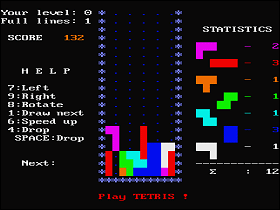 The Game: Various shapes consisting of four blocks each fall from the top of the screen, giving the player a short time to rotate, move (left or right only), and ultimately drop each piece into place. The goal is to put complementary shapes together, forming a solid line (or several solid lines) and leaving no gaps. Completed horizontal lines disappear from the screen, and the remaining pieces drop to the bottom. Bonus points are awarded for using the tallest piece – four blocks tall – to eliminate four lines at once. Allowing the shapes to pile up until they reach the top of the screen ends the game. (freeware, 1986)
The Game: Various shapes consisting of four blocks each fall from the top of the screen, giving the player a short time to rotate, move (left or right only), and ultimately drop each piece into place. The goal is to put complementary shapes together, forming a solid line (or several solid lines) and leaving no gaps. Completed horizontal lines disappear from the screen, and the remaining pieces drop to the bottom. Bonus points are awarded for using the tallest piece – four blocks tall – to eliminate four lines at once. Allowing the shapes to pile up until they reach the top of the screen ends the game. (freeware, 1986)
Memories: Created in 1984 while the programming trio of Alexey Pajitnov, Dmitry Pavlovsky and Vadim Gerasimov were working for the Soviet Academy of Sciences, Tetris was first programmed on a mainframe computer and its commercial potential was immediately recognized. Since it was designed and coded “on the clock” in Soviet government facilities, the government automatically had ownership of the program. The Soviet technology and software export bureau, Elektronorgtechnica (ELORG for short), had never dealt with a computer game, and dropped the ball. The programmers shrugged it off; Gerasimov’s MS-DOS PC port was released into the wild in 1986 with no expectation that anyone involved would ever profit from it, and that was that.
Donkey Kong
 The Game: How high can you go? Help Jumpman (Mario) save Pauline from Donkey Kong’s clutches by climbing ladders and avoiding barrels. (Ocean Software, 1986)
The Game: How high can you go? Help Jumpman (Mario) save Pauline from Donkey Kong’s clutches by climbing ladders and avoiding barrels. (Ocean Software, 1986)
Memories: Three years after the release of AtariSoft’s Commodore 64 Donkey Kong port, European software developer Ocean Software decided it was time for another Donkey Kong remake and accepted the challenge.
It goes without saying that the more familiar programmers become with a particular platform, the more advanced their games will look and play. This is generally why games released later in a platform’s lifespan often seem more advanced than earlier titles. Such is the case with Ocean’s version of Donkey Kong. With an additional three years of familiarity with the Commodore behind them, Ocean was really able to crank one great looking port.
Tower Of Doom
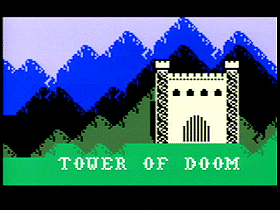
 The Game: Abandon hope, all ye who enter the Tower of Doom. Armed and armored, adventurers enter seeking treasure, mystery and glory…but all that stands between them and those goals are dragons, monsters, bizarre traps that twist space and time, and, of course, twisty little passages (there are always twisty little passages). When a battle is lost in the catacombs, the player returns to his starting point for another attempt to plumb the depths, but eventually every player will run out of opportunities…or will have to grow powerful enough to conquer most of the Tower’s denizens. (INTV Inc., 1986)
The Game: Abandon hope, all ye who enter the Tower of Doom. Armed and armored, adventurers enter seeking treasure, mystery and glory…but all that stands between them and those goals are dragons, monsters, bizarre traps that twist space and time, and, of course, twisty little passages (there are always twisty little passages). When a battle is lost in the catacombs, the player returns to his starting point for another attempt to plumb the depths, but eventually every player will run out of opportunities…or will have to grow powerful enough to conquer most of the Tower’s denizens. (INTV Inc., 1986)
Memories: Originally conceived as another entry in the Advanced Dungeons & Dragons video game franchise, Tower Of Doom seems terribly familiar to anyone who played Mattel’s original AD&D cartridge: the overhead maze crawl and the close-up battles go back to the original game’s basics, rather than trying to further develop Treasure Of Tarmin‘s first-person perspective and interface, which was considered a step forward for graphics but not for game play.
Donkey Kong Junior
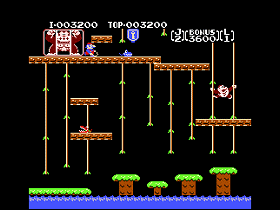 The Game: Mario has Donkey Kong in captivity, and it’s up to Donkey Kong Jr. to rescue his dad by scaling vines and chains, avoiding nasty-toothed traps and pesky birds, and reaching the key to free the great ape from Mario’s clutches. (Nintendo, 1985)
The Game: Mario has Donkey Kong in captivity, and it’s up to Donkey Kong Jr. to rescue his dad by scaling vines and chains, avoiding nasty-toothed traps and pesky birds, and reaching the key to free the great ape from Mario’s clutches. (Nintendo, 1985)
Memories: A fairly popular arcade game like Donkey Kong Junior was bound to be ported to home consoles, and the translations ran the gamut from not-good-at-all to good enough. Surely if anyone could really capture the essence of the coin-op, it’d be Nintendo itself.
Donkey Kong
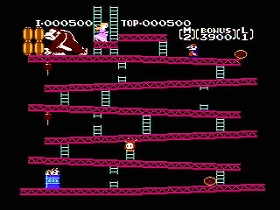 The Game: An oversized gorilla kidnaps Mario’s girlfriend and hauls her up to the top of a building which is presumably under construction. You are Mario, dodging Donkey Kong’s never-ending hail of rolling barrels and “foxfires” in your
The Game: An oversized gorilla kidnaps Mario’s girlfriend and hauls her up to the top of a building which is presumably under construction. You are Mario, dodging Donkey Kong’s never-ending hail of rolling barrels and “foxfires” in your  attempt to climb to the top of the building and topple Donkey Kong. You can actually do this a number of times, and then the game begins again with the aforementioned girlfriend in captivity once more. (Nintendo, 1986)
attempt to climb to the top of the building and topple Donkey Kong. You can actually do this a number of times, and then the game begins again with the aforementioned girlfriend in captivity once more. (Nintendo, 1986)
Memories: Once upon a time, Donkey Kong for the ColecoVision was the Donkey Kong experience to beat: short of going to the arcade, it didn’t get any better than that. But Coleco had only negotiated the console rights to the game, and nearly lost that contract when they goofed and showed a version of the game for their ill-fated Adam computer at a 1983 Consumer Electronics Show – though the home computer rights had been granted to Atari. In just two years’ time, none of that would matter – the crash came and went, Coleco exited the home computer and video game businesses, a seriously weakened Atari refocused its efforts on computer hardware, and Nintendo had its own video game console on the US market.
Donkey Kong 3
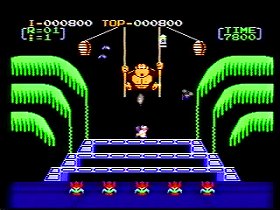 The Game: As Stanley the gardener, you’re trying to repel a swarm of pests unleashed by that meanest of pixellated gorillas, while also using your pesticide to propel him off the screen. Protect your flowers and yourself, and wear plenty of Off. (Nintendo, 1986)
The Game: As Stanley the gardener, you’re trying to repel a swarm of pests unleashed by that meanest of pixellated gorillas, while also using your pesticide to propel him off the screen. Protect your flowers and yourself, and wear plenty of Off. (Nintendo, 1986)
Memories: As much as many gamers don’t grow as attached to Donkey Kong 3 as they did with the first games in that series, with its Mario-less sidestep into shooter territory, it’s still quite a bit of fun, and this NES cartridge captures the arcade experience perfectly.
Joust 2: Survival Of The Fittest
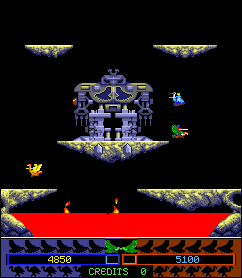
 The Game: Mount up that ostrich and ride into battle once more, this time in strange new environments such as “The Altar,” “The Blues,” a deadly mechanical warrior which can be dismantled by lancing strategic points, and crystal caves filled with killer bats. If all this sounds like too much for an armored guy on a lousy ostrich, you’re right, it is – and this is why you can transform into a Pegasus, which is a larger target and harder to keep in the air, but can take out more armored guys on lousy ostriches – and they can’t turn their steeds into flying horses. Beware, buzzard bait! (Williams, 1986)
The Game: Mount up that ostrich and ride into battle once more, this time in strange new environments such as “The Altar,” “The Blues,” a deadly mechanical warrior which can be dismantled by lancing strategic points, and crystal caves filled with killer bats. If all this sounds like too much for an armored guy on a lousy ostrich, you’re right, it is – and this is why you can transform into a Pegasus, which is a larger target and harder to keep in the air, but can take out more armored guys on lousy ostriches – and they can’t turn their steeds into flying horses. Beware, buzzard bait! (Williams, 1986)
Memories: I have to admit, I only became aware of the existence of a sequel to Williams’ immortal Joust in the late ’90s…and even now that I’ve gotten to play it, the jury’s still out. Joust needed a sequel about like The Matrix needs a sequel – meaning not at all. Both were fine as stand-alones, and didn’t need to be turned into franchises.
Super Xevious
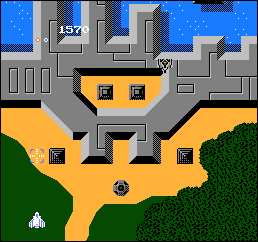 The Game: As the commander of a sleek Solvalou fighter, you’re deep into enemy territory, shooting their disc-shaped fighters out of the sky, bombing ground installations and artillery nests, bombing tanks, and trying to destroy the mothership. As you progress further behind enemy lines, heavier aircraft and more versatile and Buy this gamedeadly ground-based defenses become the norm. Also look out for tumbling airborne mirrors – they’re impervious to your fire, but you’re toast if you fly right into them. (Nintendo [under license from Namco], 1986)
The Game: As the commander of a sleek Solvalou fighter, you’re deep into enemy territory, shooting their disc-shaped fighters out of the sky, bombing ground installations and artillery nests, bombing tanks, and trying to destroy the mothership. As you progress further behind enemy lines, heavier aircraft and more versatile and Buy this gamedeadly ground-based defenses become the norm. Also look out for tumbling airborne mirrors – they’re impervious to your fire, but you’re toast if you fly right into them. (Nintendo [under license from Namco], 1986)
Memories: Adapted for the Nintendo Vs. arcade cartridge system, which used the same technology as the NES console, Super Xevious underwent a transformation, trading in its extremely vertical view for an extremely crunched horizontal/almost-square screen, typical of games which were ported to the Vs. system.
Rampage
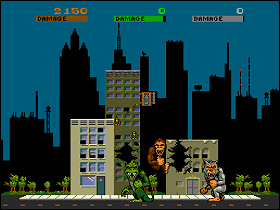 The Game: Monsters are running amok in cities across America… and you’re one of them! A giant lizard, a giant werewolf and a giant gorilla walk into a bar and tear it down. Monsters can compete to see who will topple tall buildings first, or they can qang up on puny defenseless human scum. It’s pretty easy to knock over buildings, and pretty easy to take a lot of damage from the armed forces who have been called out to stop the creatures. If they accrue too much damage, the monsters de-evolve to their un-mutated original human form, and require quick action (and additional quarters) to stay in the game. (Midway, 1986)
The Game: Monsters are running amok in cities across America… and you’re one of them! A giant lizard, a giant werewolf and a giant gorilla walk into a bar and tear it down. Monsters can compete to see who will topple tall buildings first, or they can qang up on puny defenseless human scum. It’s pretty easy to knock over buildings, and pretty easy to take a lot of damage from the armed forces who have been called out to stop the creatures. If they accrue too much damage, the monsters de-evolve to their un-mutated original human form, and require quick action (and additional quarters) to stay in the game. (Midway, 1986)
Memories: A devilishly fun masterpiece of pure destruction, Rampage appeals to any current or former kid who’s ever gained an innate understanding that the next best thing rto building something is to knock it over again. Rampage‘s implied violence is cartoonish at worst, with just a wink and a nod toward the classic Toho and Universal Studios monster movies. And that is a great combination.
Halley’s Comet
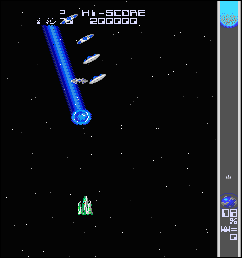 The Game: Defend Earth from the comets! Halley’s Comet is on a collision course with Earth, and it’s teeming with evil aliens bent on destroying humanity. They attack the player’s ship in endless waves, even building walls in space that the player can collide with before they realize what’s happening. Power-ups can be revealed by blasting away at meteors, though catching them and accumulating their firepower in the middle of a fierce firefight is a skill unto itself. Smaller comets plunge toward the Earth at lightning speed. Any alien ships or comets that the player doesn’t destroy keep going and attack the planet; if too many are allowed to strike at Earth directly, or if the player runs out of ships, the game ends. (Taito, 1986)
The Game: Defend Earth from the comets! Halley’s Comet is on a collision course with Earth, and it’s teeming with evil aliens bent on destroying humanity. They attack the player’s ship in endless waves, even building walls in space that the player can collide with before they realize what’s happening. Power-ups can be revealed by blasting away at meteors, though catching them and accumulating their firepower in the middle of a fierce firefight is a skill unto itself. Smaller comets plunge toward the Earth at lightning speed. Any alien ships or comets that the player doesn’t destroy keep going and attack the planet; if too many are allowed to strike at Earth directly, or if the player runs out of ships, the game ends. (Taito, 1986)
Memories: An interesting take on the slide-and-shoot genre, Halley’s Comet finally addresses what happens when dive-bombing alien invaders zoom past the player’s ship at the bottom of the screen – they keep barreling toward whatever the player was protecting in the first place. This raises the stakes nicely and holds the player accountable for any stragglers who slip past the defenses, something that most shoot-’em-ups since Space Invaders (which ended the moment the invaders landed) didn’t bother to do.
Bubble Bobble
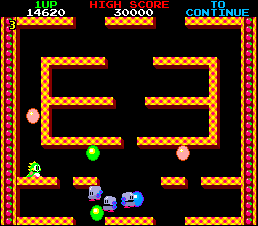
 The Game: You control a friendly-looking lizard named Bub (and, if you have a second player, they control his blue-tinged twin, Bob). Your mission is simple – use your natural defenses to do away with a multi-tiered screen full of monsters. And your natural defense? Of course, like so many members of the reptile family, you blow bubbles which trap your enemies, and then jump up to pop those bubbles (popping the predators in the process). In many cases, a just-popped enemy will deposit a tasty treat which you have to grab for bonus points within seconds before the treat vanishes. Clearing the screen of critters takes you automatically to the next level. (Taito, 1986)
The Game: You control a friendly-looking lizard named Bub (and, if you have a second player, they control his blue-tinged twin, Bob). Your mission is simple – use your natural defenses to do away with a multi-tiered screen full of monsters. And your natural defense? Of course, like so many members of the reptile family, you blow bubbles which trap your enemies, and then jump up to pop those bubbles (popping the predators in the process). In many cases, a just-popped enemy will deposit a tasty treat which you have to grab for bonus points within seconds before the treat vanishes. Clearing the screen of critters takes you automatically to the next level. (Taito, 1986)
The Game: I’m not going to delve too deeply into how original this game is (or isn’t) – one can see the Mario Bros. influence pretty clearly – but Bubble Bobble is a lot of fun, and it’s the starting point of Taito’s most enduring “cute” franchise.
Atari 7800 Prosystem
 Many home video game consoles have gone down in history as being too far ahead of their time, or being too underpowered by the time they reached the market. But the Atari 7800 – a high-end but low-priced system concocted by Atari to compete with such systems as the ColecoVision/ADAM and the growing share of the gaming market being engulfed by the home computer market – was truly a machine that was in the wrong place at the wrong time.
Many home video game consoles have gone down in history as being too far ahead of their time, or being too underpowered by the time they reached the market. But the Atari 7800 – a high-end but low-priced system concocted by Atari to compete with such systems as the ColecoVision/ADAM and the growing share of the gaming market being engulfed by the home computer market – was truly a machine that was in the wrong place at the wrong time.
The 7800 was created and engineered around 1985 by General Computer, the firm to whom  Atari had been outsourcing the bulk of game development for the 5200 and 2600, and it looked like Atari had learned its lessons from the marketing debacle that was the 5200 SuperSystem. Perhaps its most compelling feature, aside from its price, was the fact that the 7800 was backward-compatible (or, at least, was supposed to be) with the ubiquitous Atari 2600. The 5200 had skipped this obvious concession to the hundreds of thousands of 2600 owners, and by offering an inexpensive 2600 Expansion Module for its machine before Atari got around to doing the same for the 5200, Coleco took the gold, winning the hearts of consumers everywhere by not forcing them to start from scratch and abandon their large 2600 game libraries. The 7800 was designed to avoid that problem altogether, and no module was necessary: the cartridges for both machines were identically shaped. Everything went into the same slot.
Atari had been outsourcing the bulk of game development for the 5200 and 2600, and it looked like Atari had learned its lessons from the marketing debacle that was the 5200 SuperSystem. Perhaps its most compelling feature, aside from its price, was the fact that the 7800 was backward-compatible (or, at least, was supposed to be) with the ubiquitous Atari 2600. The 5200 had skipped this obvious concession to the hundreds of thousands of 2600 owners, and by offering an inexpensive 2600 Expansion Module for its machine before Atari got around to doing the same for the 5200, Coleco took the gold, winning the hearts of consumers everywhere by not forcing them to start from scratch and abandon their large 2600 game libraries. The 7800 was designed to avoid that problem altogether, and no module was necessary: the cartridges for both machines were identically shaped. Everything went into the same slot.
Sadly, the Tramiel family’s takeover of Atari from Warner Bros. put the 7800 into an R&D deep freeze. The machine didn’t see the light of day until 1987, by which time Nintendo ruled the world with the NES. And while the NES was basking in the killer-app glow of games like the Super Mario Bros. series, The Legend Of Zelda and a little thing called Tetris, the 7800 was still leaning on such early-80s Atari staples as Xevious, Ms. Pac-Man and Pole Position II. The 7800 became the Rip Van Winkle of the home video game race: a system that, through no fault of its own, had slept too long.
[jwcatpostlist orderby=title order=asc includecats=17]
The Oregon Trail (1985 version)
 The Game: Hitch up your wagons and head west! It’s 1848 and you and your family are provisioning a covered wagon to leave Independence, Missouri to reach Oregon by the end of the year (and before the weather turns against you). You decide your character’s skills/background, how much of your limited funds to spend on supplies ranging from food to to clothes to wagon spares to ammunition, and you set out westward. There are many stops along the way, and many hazards to face – and plenty of ways to die on the journey that don’t even involve dysentery. (Minnesota Educational Computer Corporation, 1985)
The Game: Hitch up your wagons and head west! It’s 1848 and you and your family are provisioning a covered wagon to leave Independence, Missouri to reach Oregon by the end of the year (and before the weather turns against you). You decide your character’s skills/background, how much of your limited funds to spend on supplies ranging from food to to clothes to wagon spares to ammunition, and you set out westward. There are many stops along the way, and many hazards to face – and plenty of ways to die on the journey that don’t even involve dysentery. (Minnesota Educational Computer Corporation, 1985)
Memories: Let’s just jump straight to the end of the review and point out something that’s already very well known – The Oregon Trail is one of the best constructed educational software titles in the history of educational software titles. It’s not just informative, but fun and suspenseful and immersive as well.
Now back to the beginning of the review: how in the world does one create an educational game – one of the genres most dreaded by young players throughout the history of computer software – and make it a really good game for the ages? Surely that takes years and years of development, right?
Transformers
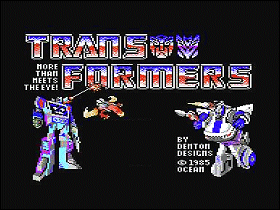 The Game: The raging battle between the Autobots and Decepticons continues in this exclusive title for the Commodore 64 computer. Take control of five different Transformers in the Autobots’ quest for Energon. (Ocean Software, 1985)
The Game: The raging battle between the Autobots and Decepticons continues in this exclusive title for the Commodore 64 computer. Take control of five different Transformers in the Autobots’ quest for Energon. (Ocean Software, 1985)
Memories: Back before fantastic graphics and CGI cut scenes, videogames often included additional paper documentation to explain who the characters where and what you were supposed to be doing. Atari, for example, packaged comic books with many of their games to add depth and back stories to their titles. Some early games relied so heavily on this documentation that without it, the games were difficult to play and didn’t make much sense. Ocean’s Transformers title was one of those games.
Super Zaxxon
 The Game: As the pilot of a lone fighter infiltrating a spaceborne fortress, your mission is simple – survive long enough to vanquish the evil Super Zaxxon robot hidden deep within the fortress, and take out as much of the defenses as you can in the meantime. (Sega, 1985)
The Game: As the pilot of a lone fighter infiltrating a spaceborne fortress, your mission is simple – survive long enough to vanquish the evil Super Zaxxon robot hidden deep within the fortress, and take out as much of the defenses as you can in the meantime. (Sega, 1985)
Memories: Just as Super Zaxxon in the arcades was merely a rewrite of the code for the original Zaxxon, it’s somehow fitting that the same is true for Super Zaxxon on the Apple II. But while it may have saved Sega some development time to reuse the code from Datamost’s version of Zaxxon for the Apple, it didn’t exactly result in a satisfying gaming experience.
RACTER
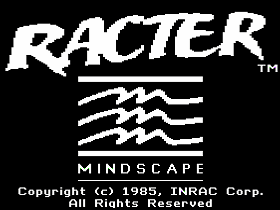 The Game: The player engages in conversation with RACTER (short for raconteur) in normal English sentences via the keyboard. RACTER responds with phrases that may (or may not) be relevant and may (or may not) make sense as part of a cohesive conversation. (Mindscape, 1985)
The Game: The player engages in conversation with RACTER (short for raconteur) in normal English sentences via the keyboard. RACTER responds with phrases that may (or may not) be relevant and may (or may not) make sense as part of a cohesive conversation. (Mindscape, 1985)
Memories: RACTER had a build-up of hype like no other non-sequel, non-movie-based program in its day – as well as a set of consumer expecatations that it probably had absolutely no chance whatsoever of meeting. After all, could a program running on a floppy disk on a home computer equipped with 64K of RAM really boast true artificial intelligence?
Project Space Station
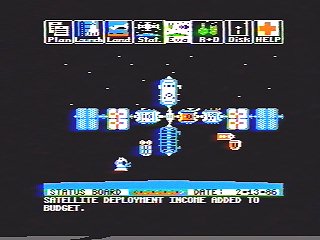 The Game: You are the administrator of NASA. Your goal? To launch the necessary components of a full-scale space station, assemble them in orbit, and initiate and maintain any number of commercial or medical research projects aboard your orbital laboratory. You will also be in charge of launching satellites for commercial and military clients. As fun as all of these activities may sound, they don’t come without a price tag. The cost for everything from necessary space hardware, to time spent in the planning stages, to launches and landings, to maintaining the bare essentials of survival in orbit, will reach into the billions of dollars…if you’re good at this game. (HESware, 1985)
The Game: You are the administrator of NASA. Your goal? To launch the necessary components of a full-scale space station, assemble them in orbit, and initiate and maintain any number of commercial or medical research projects aboard your orbital laboratory. You will also be in charge of launching satellites for commercial and military clients. As fun as all of these activities may sound, they don’t come without a price tag. The cost for everything from necessary space hardware, to time spent in the planning stages, to launches and landings, to maintaining the bare essentials of survival in orbit, will reach into the billions of dollars…if you’re good at this game. (HESware, 1985)
Memories: An incredibly fun and very complex game, Project Space Station is a SimCity-style simulation with elements that appeal to almost anyone, including arcade-style action screens. But there are also aspects of the game – such as the budgeting screen (left) – that can best be appreciated by older players.
Mail Order Monsters
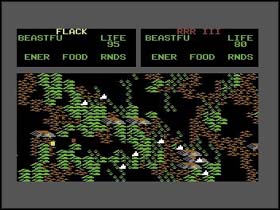 The Game: Put your money where your fangs are in this monster mash-up that pits twelve different types of creatures against each other in the ultimate battle for survival. Arm your creature with the best weapons and armor to prepare him for games of Capture the Flag, Tournament-Style Battles, or an all out invasion. (Electronic Arts, 1985)
The Game: Put your money where your fangs are in this monster mash-up that pits twelve different types of creatures against each other in the ultimate battle for survival. Arm your creature with the best weapons and armor to prepare him for games of Capture the Flag, Tournament-Style Battles, or an all out invasion. (Electronic Arts, 1985)
Memories: In the fall of 1985, my parents opened Yukon Software, a computer store specializing in PC, Apple and Commodore software. Every week I drooled over the stacks of brand new games my parents received to stock their shelves with. Occasionally I’d talk my dad into letting me open a game to demo it on one of our in-store computers. Mail Order Monsters was one of those games. The thought of building and battling monsters really appealed to me as a young teenager, a fantasy Mail Order Monsters delivered.
Little Computer People
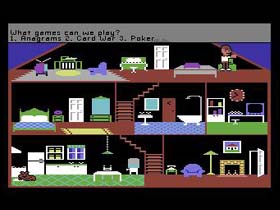 The Game: Does it ever seem like your computer has a mind of its own? Maybe it does! Activision’s Little Computer People provides computer owners with a virtual three-story house, designed to lure the computer people out of your wiring and into a hospitable habitat. Once a little person has moved into his new home he can be studied and observed, but this is no hands-off experiment. You’ll need to keep your new friend happy and fed to maintain a healthy relationship. (Activision, 1985)
The Game: Does it ever seem like your computer has a mind of its own? Maybe it does! Activision’s Little Computer People provides computer owners with a virtual three-story house, designed to lure the computer people out of your wiring and into a hospitable habitat. Once a little person has moved into his new home he can be studied and observed, but this is no hands-off experiment. You’ll need to keep your new friend happy and fed to maintain a healthy relationship. (Activision, 1985)
Memories: When Little Computer People first came out, it was difficult to explain just what kind of program it was to your friends. These days, it’s much easier – I’d simply say the game was like The Sims, but with only one sim and one location. To anyone familiar with the SimCity/SimAnt/SimEarth series of games, I’d describe it as a “SimHouse”. I might even compare the game to one of those popular “virtual pet” programs. But Little Computer People came out in 1985, prior to any of those games. Back then we lacked the vocabulary to describe (much less categorize) the game. Little Computer People was first released for the Commodore 64, quickly ported to the Apple II, and eventually found its way to Atari, Amiga, Amstrad and Sinclair computers. The game was never ported to the PC.
High Rise
 The Game: Think of it as the anti-Tetris. Five hoppers dispense geometric shapes on your command. As Barnaby, you move the pieces into place to build the most stable structure you possibly can, and if you manage to build a high enough tower, you climb to the top and advance to the next level. The first level’s shapes are fairly easy, but as you advance through levels, the pieces take on stranger and stranger shapes – and balancing them becomes harder. In later levels, you start rounds with oddball shapes already in place on the playing field, making your task that much harder. The game ends when the timer runs out without the completion of a stable structure. (Micro Learn, 1985)
The Game: Think of it as the anti-Tetris. Five hoppers dispense geometric shapes on your command. As Barnaby, you move the pieces into place to build the most stable structure you possibly can, and if you manage to build a high enough tower, you climb to the top and advance to the next level. The first level’s shapes are fairly easy, but as you advance through levels, the pieces take on stranger and stranger shapes – and balancing them becomes harder. In later levels, you start rounds with oddball shapes already in place on the playing field, making your task that much harder. The game ends when the timer runs out without the completion of a stable structure. (Micro Learn, 1985)
Memories: Move over, Bob the Builder. This inventive little learning game, designed to teach correlations between shapes, is addictive no matter what your age is – and frankly, I’m disappointed that it hasn’t been reborn as a simple PC game, or perhaps a Game Boy title.
Ghostbusters
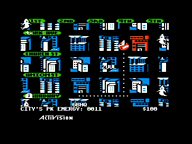 The Game: Supernarural, paranormal investigations and eliminations are the order of the day, as you open your own ghost busting franchise. You start with a finite budget and have to make some savvy choices about vehicles and gear; then it’s time to strap on a proton pack, get behind the wheel of the Ectomobile, and cruise around the Big Apple watching for flashing red buildings (telltale signs of a poltergeist party in progress). When you arrive on the scene, a little bit of driving is required, which gives you the chance to mop up a few free-roaming full-torso vaporous apparitions off the streets,
The Game: Supernarural, paranormal investigations and eliminations are the order of the day, as you open your own ghost busting franchise. You start with a finite budget and have to make some savvy choices about vehicles and gear; then it’s time to strap on a proton pack, get behind the wheel of the Ectomobile, and cruise around the Big Apple watching for flashing red buildings (telltale signs of a poltergeist party in progress). When you arrive on the scene, a little bit of driving is required, which gives you the chance to mop up a few free-roaming full-torso vaporous apparitions off the streets,  before you arrive at your destination and try to trap a ghost without crossing the streams. All the while, supernatural forces are converging on a site formerly known as the temple of Zuul, and when the paranormal powers there reach a critical mass, it’s time for roasted marshmallow – or the end of the world. (Activision, 1985)
before you arrive at your destination and try to trap a ghost without crossing the streams. All the while, supernatural forces are converging on a site formerly known as the temple of Zuul, and when the paranormal powers there reach a critical mass, it’s time for roasted marshmallow – or the end of the world. (Activision, 1985)
Memories: A nice balance of arcade action segments and some resource-management strategy, Ghostbusters manages to capture the inherent humor of the movie (failure to capture a ghost results in one or both of your men getting “slimed”) and yet succeeds as a game too.
Garry Kitchen’s Game Maker
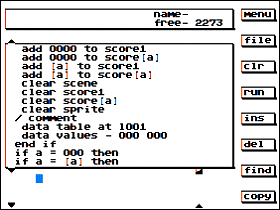 The Game: You decide what the game’s going to be. From creating your own characters, animating them, building their world (and the physical rules that govern it) and setting up the conflicts and limits, you have a powerful game-making tool at your disposal. Use it wisely, make something fun, and learn a little bit about how video games are conceived and programmed. (Activision, 1985)
The Game: You decide what the game’s going to be. From creating your own characters, animating them, building their world (and the physical rules that govern it) and setting up the conflicts and limits, you have a powerful game-making tool at your disposal. Use it wisely, make something fun, and learn a little bit about how video games are conceived and programmed. (Activision, 1985)
Memories: Almost a transcendental work of genius, Game Maker is one of those programs that, if you were around (and of a certain age) when it was released, you remember it vividly. This is one of those things that probably changed a few lives.
Friday The 13th
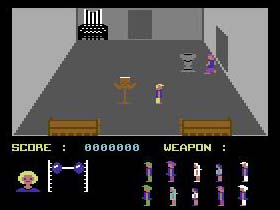 The Game: Find Jason Voorhees and destroy him before he slaughters your friends in this game based on the popular horror movie franchise. People will definitely die; the only questions are who, when, and by whom. (Dormark, 1985)
The Game: Find Jason Voorhees and destroy him before he slaughters your friends in this game based on the popular horror movie franchise. People will definitely die; the only questions are who, when, and by whom. (Dormark, 1985)
Memories: I can still remember the night I got Friday The 13th for my Commodore 64. My friends and I were big fans of all the big ’80s horror icons such as Jason (Friday The 13th), Freddy (Nightmare On Elm Street), and Michael Myers (Halloween). The thought of playing a videogame based off of one of those movies at that time was both exciting and a little scary for us young’uns. Fortunately for our young minds, the scariest thing about Friday The 13th for the Commodore 64 was the actual gameplay.
Doctor Who and the Warlord
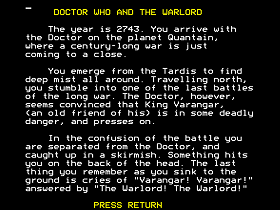 The Game: You are the Doctor’s companion, separated from the Time Lord during an attempt to save the Doctor’s old friend, King Varangar. When you come to, the Doctor is nowhere around, you’re unarmed, and you’re surrounded by deadly swamps, war zones, and hostile alien soldiers. Your life expectancy away from the TARDIS isn’t looking terribly good – and even if you can reunite with the Doctor, escaping from planet Quantain won’t be easy. (BBC Software, 1985)
The Game: You are the Doctor’s companion, separated from the Time Lord during an attempt to save the Doctor’s old friend, King Varangar. When you come to, the Doctor is nowhere around, you’re unarmed, and you’re surrounded by deadly swamps, war zones, and hostile alien soldiers. Your life expectancy away from the TARDIS isn’t looking terribly good – and even if you can reunite with the Doctor, escaping from planet Quantain won’t be easy. (BBC Software, 1985)
Memories: The second official Doctor Who computer game, released during the show’s mid-1980s merchandising heyday, Doctor Who And The Warlord is a decisive step away from the somewhat derivative arcade-inspired game play of Doctor Who: The First Adventure… and a step toward another well-worn style of game: the text adventure.
Create With Garfield!
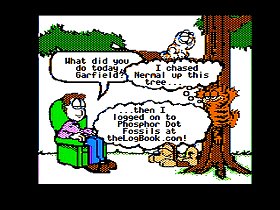 The Game: Using a simple drag-and-drop system (controlled by keyboard, mouse or joystick), put the elements of an original Garfield comic into place, including everyone’s favorite big orange cat, Odie, Jon, Nermal and all the fixtures and fittings of home (including a big burger and some lasagna). Then position speech balloons in the appropriate place, containing either signature Garfield catchphrases or your own words. Print and/or save to disk, repeat ad nauseum, and avoid Jim Davis’s lawyers thereafter! (Developmental Learning Materials, 1985)
The Game: Using a simple drag-and-drop system (controlled by keyboard, mouse or joystick), put the elements of an original Garfield comic into place, including everyone’s favorite big orange cat, Odie, Jon, Nermal and all the fixtures and fittings of home (including a big burger and some lasagna). Then position speech balloons in the appropriate place, containing either signature Garfield catchphrases or your own words. Print and/or save to disk, repeat ad nauseum, and avoid Jim Davis’s lawyers thereafter! (Developmental Learning Materials, 1985)
Memories: This nifty bit of creative software used to keep me entertained for hours on end. With a bit of advanced option tweaking, it was even possible to import standard hi-res images to use as the background for a scene, so it wasn’t impossible to, say, drop Odie into the middle of a saved image of an Ultima IV meleè. Not that I’d do such a thing, of course.
Adventure Construction Set
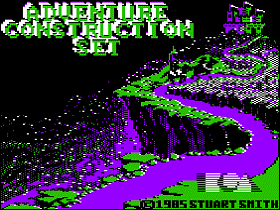 The Game: Digital dungeon masters never had it so good. From the design of tiles and characters to the basic rules governing the player’s interactions with his world, it’s all up for grabs. Items can be placed, their abilities defined, and enemies can be generated. Let the games begin…but is it more fun to create them or play them? (Electronic Arts, 1985)
The Game: Digital dungeon masters never had it so good. From the design of tiles and characters to the basic rules governing the player’s interactions with his world, it’s all up for grabs. Items can be placed, their abilities defined, and enemies can be generated. Let the games begin…but is it more fun to create them or play them? (Electronic Arts, 1985)
Memories: Offering everything from pre-built elements to user-defined items and characters from scratch, Adventure Construction Set was a revelation. Where Garry Kitchen‘s Game Maker from Activision allowed budding game designers to create their own arcade-style games, EA‘s Adventure Construction Set gave them control of a top-down, tile-based 2-D adventure game. Those familiar with the Ultima series or Questron would instantly be within their element.
Dig Dug
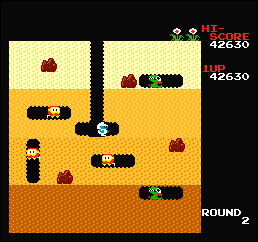 The Game: Who said landscaping was easy? You are Dig Dug, an intrepid gardener whose soil is infested with pesky Pookas and fire-breathing Fygars. You’re armed with your trusty pump, which you can use to inflate your enemies until, finally, they blow up. But both the Pookas and Fygars can crawl through the ground and can pop out into your tunnels, and if a Fygar sneaks up behind you, he can toast you if you’re not careful. (Namco, 1985)
The Game: Who said landscaping was easy? You are Dig Dug, an intrepid gardener whose soil is infested with pesky Pookas and fire-breathing Fygars. You’re armed with your trusty pump, which you can use to inflate your enemies until, finally, they blow up. But both the Pookas and Fygars can crawl through the ground and can pop out into your tunnels, and if a Fygar sneaks up behind you, he can toast you if you’re not careful. (Namco, 1985)
Memories: For some reason that I have a hard time trying to fathom, this game was released for the Famicom only – the Japanese console which was re-engineered as the NES for the English-speaking market. The reason I can’t fathom that is that this is a perfectly playable port of Dig Dug. Did Namco really think that this cute classic was past its sell-by date in the States?
Wrecking Crew
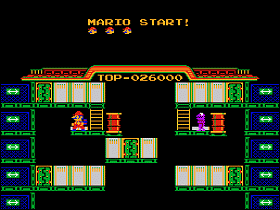 The Game: Mario toils away on a construction site when his tools turn against him and start acting like, well, tools. Now Mario has to outfox his own tools and demolish the platforms around them – maybe taking the tools out in the process. He has his trusty hammer, and strategically placed bombs help to speed the process as well (but can be dangerous if Mario hangs around too close). Great care must be taken to demolish the structures in the correct order so access isn’t cut off to areas needed to finish the level. (Nintendo, 1985)
The Game: Mario toils away on a construction site when his tools turn against him and start acting like, well, tools. Now Mario has to outfox his own tools and demolish the platforms around them – maybe taking the tools out in the process. He has his trusty hammer, and strategically placed bombs help to speed the process as well (but can be dangerous if Mario hangs around too close). Great care must be taken to demolish the structures in the correct order so access isn’t cut off to areas needed to finish the level. (Nintendo, 1985)
Memories: Possibly the most obscure of Mario’s career detours, this game at least depicts Mario in the same job he was pursuing before Donkey Kong came along: as a construction worker of some kind, rather than a plumber. At its heart, though, Wrecking Crew is about blowing stuff up – in the right order – rather than building anything. It’s a neat puzzle game disguised as a platformer.
Super Mario Bros. / Duck Hunt
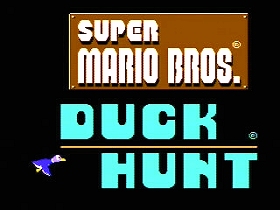 The Game: Intrepid plumbers Mario and Luigi have fallen back on Mario’s original mandate – rescuing the damsel – as they journey through the kingdom, battling Koopas and braving falls from dizzying heights, all to
The Game: Intrepid plumbers Mario and Luigi have fallen back on Mario’s original mandate – rescuing the damsel – as they journey through the kingdom, battling Koopas and braving falls from dizzying heights, all to  rescue the princess (who, as always, seems to be in another castle). In Duck Hunt things are a bit more normal – you’re just trying to nail some ducks in the wild, with the help and encouragement (and, if you let one get away, derisive laughter) from your trusty huntin’ dawg. (Nintendo, 1985)
rescue the princess (who, as always, seems to be in another castle). In Duck Hunt things are a bit more normal – you’re just trying to nail some ducks in the wild, with the help and encouragement (and, if you let one get away, derisive laughter) from your trusty huntin’ dawg. (Nintendo, 1985)
Memories: Right up there with Atari 2600 Pac-Man in ubiquity, and almost universally loved (think about that for a moment – how many video games reach quite that level of popularity?), Super Mario Bros. was the ticket the NES needed to break into the U.S. market.
Pac-Man
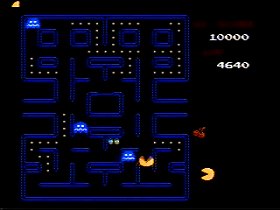 The Game: As a round yellow creature consisting of a mouth and nothing else, you maneuver around a relatively simple maze, gobbling small dots (10 points) and evading four colorful monsters who can eat you on contact. In four corners of the screen, large flashing dots (50 points) enable you to turn the tables and eat the monsters
The Game: As a round yellow creature consisting of a mouth and nothing else, you maneuver around a relatively simple maze, gobbling small dots (10 points) and evading four colorful monsters who can eat you on contact. In four corners of the screen, large flashing dots (50 points) enable you to turn the tables and eat the monsters  for a brief period for an escalating score (200, 400, 800 and 1600 points). Periodically, assorted items appear near the center of the maze, and you can consume these for additional points as well. The monsters, once eaten, return to their home base in ghost form and return to chase you anew. If cleared of dots, the maze refills and the game starts again, but just a little bit faster… (Tengen, 1985)
for a brief period for an escalating score (200, 400, 800 and 1600 points). Periodically, assorted items appear near the center of the maze, and you can consume these for additional points as well. The monsters, once eaten, return to their home base in ghost form and return to chase you anew. If cleared of dots, the maze refills and the game starts again, but just a little bit faster… (Tengen, 1985)
Memories: You’ve gotta hand it to Atari – back in the day, they were the experts at exploiting a license until just about every possible option was exhausted. They were also quite adept at staying on the map – up to a point. Where this title might have been released by Atarisoft only a year or two earlier, Atari set up a new imprint – Tengen – to create and market games for the NES. By virtue of Atari’s existing license with Namco, Tengen threrefore produced the first NES port of Pac-Man, and Namco later released its own. (It’s worth noting that the Namco-Atari connection – forged in the late 70s when Namco distributed Atari arcade games in Japan – wasn’t history just yet; Atari later handled the American release of Namco’s Pac-Mania coin-op.)